Books on Puzzles
An annotated bibiography by Michael Keller
This is a list of books on puzzles in general, and on specific puzzles
for which we do not have guides. Books on
cryptarithms and twisting puzzles can be found in their respective
articles on the main Puzzle Laboratory page; selected books on Latin
square puzzles will appear in an upcoming article on sudoku and related
puzzles.
Beyond series
Noted game inventor Sid Sackson published a series of five books of
original pencil-and-paper games, designed to be played with colored
pens on pencils, with multiple copies of tear-out sheets for each
game. They sold for $2.95 each.
Sackson, Sid -- Beyond Tic Tac Toe, 1975, Pantheon, unnumbered, paperback, ISBN 0-394-83136-5
Seven games (all but one for 2, 3, or 4 players) named after famous artists, and designed to suggest the work of each artist.
Sackson, Sid -- Beyond Solitaire, 1976, Pantheon, unnumbered, paperback, ISBN 0-394-83304-X
Six games for 1 players using dice. The back cover is printed with 18 dice cards.
Sackson, Sid -- Beyond Words, 1977, Pantheon, unnumbered, paperback, ISBN 0-394-83444-5
Six word games for 2 or more players, named for famous authors.
Sackson, Sid -- Beyond Competition, 1977, Pantheon, unnumbered, paperback, ISBN 0-394-83605-7
Seven cooperative games (all but one for 2, 3, or 4 players) using 24
playing cards (1-6 in four suits; also printed on the back cover).
Sackson, Sid -- Calculate!, 1979, Pantheon, unnumbered, paperback, ISBN 0-394-84222-7
Six games for 2 or more players, using a calculator.
Disentanglement Puzzles
En, Yu Chong, and Zhang Wei -- Ingenious Rings, 1999, [Beijing] China
Children's Publishing House, 152pp., paperback, ISBN 7-5007-5002-1
{Chinese}
Illustrated guide to Chinese ring puzzles. In Chinese with
an English Introduction. Some of the solutions can be
muddled through with diagrams. Exchange item for the 4th
Gathering For Gardner, February 2000. (Jerry Slocum had a
translation by Yenna Wu printed for the Fourth International Puzzle
Party in 1981).
Dissections
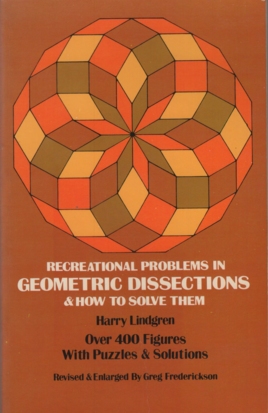
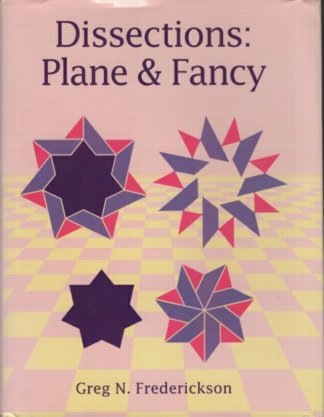
Lindgren, Harry -- Geometric Dissections, 1964, D. Van Nostrand
Frederickson, Greg -- Recreational Puzzles in Geometric Dissections
& How to Solve Them, 1972, Dover, 184pp., paperback, ISBN
0-486-22878-9, $3.50
Revised and enlarged edition of Lindgren's original, in collaboration
with Lindgren. A detailed guide to the field of dissections
(geometric figures cut into pieces and reassembled into different
figures), related to the fields of tiling and polyforms.
Profusely illustrated in monochrome.
Frederickson, Greg N. -- Dissections: Plane & Fancy, 1997, Cambridge University Press, 310pp., hardback, ISBN 0-521-57197-9
Entertaining and definitive historical survey of dissections, including
capsule biographies of dozens of notables in the field.
Beautifully illustrated in monochrome, with a 9-page bibliography and a
numerical index of all of the dissections described, as well as a
general index. In my view one of the finest books ever
published in the puzzle field.
Coffin, Stewart T. -- The Puzzling World of Polyhedral Dissections,
1990, Oxford University Press, 196pp., ISBN 0-19-853207-5 (paperback
ISBN 0-19-286133-6)
Fine survey of dissection puzzles, many of them the author's own
inventions. An expansion of the author's self-published paperback
Puzzle Craft. Good chapter on polyforms; most of the book covers
three-dimensional puzzles, including polycubes and burrs.
Well-illustrated.
Yoshigahara, Nob -- Puzzle in Wood, 1987, Puzzland Hikimi, 110pp., hardback, ISBN 4-915661-19-9 {Japanese}
Collection of wooden puzzles made by the Japanese company Puzzland
Hikimi. In Japanese, but with monochrome photos and solution
diagrams.
General Collections
Ball, W.W. Rouse, and H.S.M. Coxeter -- Mathematical Recreations and
Essays, Thirteenth Edition, 1987, Dover, 428pp., paperback, ISBN
0-486-25357-0, $8.95
Botermans series
Van Delft, Pieter, and Jack Botermans -- Creative Puzzles of the World,
1978, [New York] Harry N. Abrams, 200pp., hardback, ISBN 0-8109-0765-8
First in a series of surveys of puzzles, beautifully illustrated with
diagrams and photographs in full color with hundreds of
solutions. Excellent coverage of most kinds of puzzles of the
pre-twisting era (Rubik's Cube was just becoming popular when this book
was published). Slightly flawed by the lack of an index.
Slocum, Jerry, and Jack Botermans -- Puzzles Old and New, How to Make
and Solve Them, 1986 [Seattle] U.Washington Press, 160pp., hardback,
ISBN 0-295-96350-6
Second in the series, emphasizing the making of puzzles. Only a
two page article on twisting puzzles, most of which is taken up by a
photograph of dozens of puzzles. Still no index, but a
three-page bibliography.
Slocum, Jerry, and Jack Botermans -- New Book of Puzzles, 101 Classic
and Modern Puzzles to Make and Solve, 1992 [New York] W.H. Freeman,
128pp., hardback, ISBN 0-295-96350-6
Third in the series, with a smaller selection of puzzles but more
detailed instructions on making them. No twisting puzzles at
all. Finally an index.
Slocum, Jerry, and Jack Botermans -- The Book of Ingenious and
Diabolical Puzzles, 1994 [New York] Times Books (Random House), 128pp.,
hardback, ISBN 0-295-96350-6
Fourth in the series, with a lot of history of the puzzles covered. Superficial coverage of twisting puzzles.
Brandreth,
Gyles -- The Puzzle Mountain, Allen Lane/Penguin,
1981,
ISBN 1-85051-155-1
Nice collection of assorted puzzles, including some cryptarithms,
mainly on pp. 176-177 and p. 195.
Costello, Matthew J. -- The Greatest Puzzles of All Time, 1988, Prentice Hall, 181pp., paperback, ISBN 0-13-364936-9, $10.95
A historical survey by an author who admits he likes the stories behind puzzles more than the puzzles themselves.
Hunter, J.A.H., and Joseph S. Madachy -- Mathematical Diversions, 1963,
1975, Dover, 178pp., paperback, ISBN 0-486-23110-0, $2.75
Knuth, Donald E. -- The Art of Computer Programming, Volume 4B,
Combinatorial Algorithms, Part 2, 2023, Addison-Wesley, 714 pp.,
hardback, ISBN 978-0-201-03806-4, $79.99
Part of Dr. Knuth's iconic series of books on computer
algorithms. This book is full of hundreds of problems in a wide
variety of puzzles such as chessboard problems, logic puzzles,
polyforms, and sudoku.
Kraitchik, Maurice -- Mathematical Recreations, 1942, 1953, Dover, 330pp., paperback, ISBN 0-486-21063-5, $5.00
Madachy, Joseph S. -- Madachy's Mathematical Recreations, 1966, 1979, Dover, 253pp., paperback, ISBN 0-486-23762-1, $3.25
Rubin, Don -- What's The Big Idea?, 1979, [Philadelphia] J.B. Lippincott, unnumbered, paperback, ISBN 0-397-01356-6, $3.95
36 visual puzzles, particularly notable for #19, Lots of Luck, the
first of a genre invented by Rubin, now usually called parking lot
puzzles.
Rubin, Don -- Those Incredible Puzzles, 1980, Lippincott and Crowell, 96pp., paperback, ISBN 0-690-01974-2, $4.95
36 more puzzles, including a maze set in a three-story house.
Rubin, Don -- Brainstorms, 1988, Perennial, 127pp., paperback, ISBN 0-06-096338-7, $9.00
50 more puzzles, including a mate-in-two chess puzzle on a Mobius-strip board.
Rubin, Don -- More Brainstorms, 1990, HarperPerennial, 128pp., paperback, ISBN 0-06-096829-X, $9.00
50 more puzzles, including another Lots of Luck, and a chess puzzle on
a warped puzzle where some of the pieces (including both kings) are
hidden.
Schuh, Fred. -- The Master Book of Mathematical Recreations, 1943, 1968, Dover, 430pp., paperback, ISBN 0-486-22134-2, $4.95
Silverman, David L. -- Your Move, 1971, 1991, Dover, 221pp., paperback, ISBN 0-486-26731-8, $8.95
80 problems with solutions, plus 20 unsolved problems.
Topics range from card and board games to mathematical puzzles to
real-life situations.
Vecchione, Glen -- Challenging Math Puzzles, 1998, Sterling, 96pp., ISBN 0-8069-6377-8, $4.95
Wells, David -- The Penguin Book of Curious and Interesting Puzzles, 1992 Penguin, 382pp., paperback, ISBN 0-14-014875-2
Anthology of puzzles from a variety of sources, including the works of Dudeney and Loyd.
LogicMazes
A new genre of maze puzzles invented by Robert Abbott, in which the
rules and conditions controlling where you can go change as you go
through the puzzle. One example is the Rolling Cube Maze, where a die
moves through the maze, turning with each step, and the number showing
constrains your moves.
Abbott, Robert -- Mad Mazes, 1990, Bob Adams, 40pp., hardback, ISBN 1-55850-865-1, $14.95 (paperback 1-55850-142-8, $7.95)
20 original maze puzzles, illustrated in full color. Separate sections
of hints and full solutions. The last puzzle, Theseus and the
Minotaur, is one of Abbott's best-known creations; essentially a
solitaire abstract board game where the opponent moves according to
fixed rules.
Abbott, Robert -- SuperMazes, 1997, primapublishing.com, 63 pp., paperback, ISBN 0-7615-0701-9, $14.00
24 more original maze puzzles.
Logic Puzzles
Emmet, E.R. -- Puzzles For Pleasure, 1972, Emerson, 310pp., hardback, ISBN 0-517-24313X
Collection of 102 logic and arithmetic puzzles, including ten hidden cryptarithms. Full solutions provided.
Emmet, E.R. -- 101 Brain Puzzlers, 1967, 1970, Barnes and Noble, 154 pp., paperback, ISBN 06-463368-3
101 more puzzles, including 19 mostly hidden cryptarithms.
Magic Squares
Andrews, W.S. -- Magic Squares and Cubes, 1917, 1960, Dover, 419pp., paperback, ISBN 0-486-20658-0, $5.00
Benson, William H., and Oswald Jacoby -- New Recreations With Magic
Squares, 1976, Dover, 198pp., paperback, ISBN 0-486-23236-0, $4.00
Benson, William H., and Oswald Jacoby -- Magic Cubes, New Recreations, 1981, Dover, 142pp., paperback, ISBN 0-486-24140-8, $4.00
Moran, Jim -- The Wonders of Magic Squares, 1982, Vintage, 227pp., paperback, ISBN 0-394-74798-4, $5.95
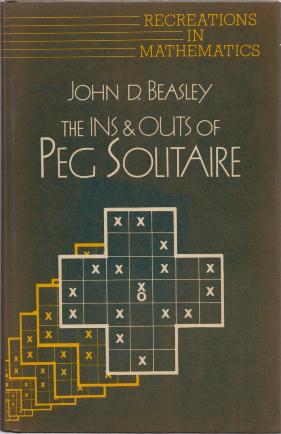
Peg Solitaire
Beasley, John D. -- The Ins & Outs of Peg Solitaire,
1985, Oxford University Press, 275 pp., hardback, ISBN 0-19-853203-2,
£15.00
Like Hordern below, a definitive work and one of the best puzzle
books ever written. Covers the 33-hole English board in
considerable detail, with solutions and mathematical theory, and others
including the 37-hole French board, as well as triangular
solitaire. Includes a Selected Biliography which is
nevertheless quite detailed and annotated, and a Glossary.
[my review from WGR7, October 1987, p.20]
Peg solitaire is one of the three largest categories of the
puzzle family known as sequential movement puzzles (the other two are
sliding piece puzzles and twisting puzzles). Peg solitaire has
been popular for at least 250 years, and much of the underlying theory
is well understood. John Beasley has researched the field
extensively, and has produced a comprehensive guide to the theory and
practice of peg solitaire. After an introductory chapter
giving rules, history, and some simple problems, Beasley jumps right
into the theory of the game. Chapter 2 is devoted to some basic
techniques for solving. These tools alone may enable even a
novice to solve simple problems. The next five chapters cover
more complex aspects of theory, but the only mathematics required is
arithmetic and simple algebra. Beasley then considers short
solutions (fewest moves used to solve a problems), long solutions (most
pegs jumped in a single move), and problems with symmetrical final
positions.
Most of the book concentrates on problems for the popular cross-shaped
33-hole board, but later chapters cover the octagonal 37-hole board,
square boards, and other shapes. Naturally much of the theory in
earlier chapters is applicable to boards of any shape. Solitaire
with six and eight directions of movement (as opposed to the four of
ordinary solitaire) and even three-dimensional solitaire are discussed
briefly. The final chapter of the book speculates on the future
of peg solitaire, including the increasing use of computers to solve
problems. An excellent bibliography (over 50 items), glossary (over 100
terms), and index are included. The Ins and Outs of Peg
Solitaire can be enjoyed by the experienced solitaire player as well as
the novice, and one can absorb as much or as little of the mathematical
theory as desired. Beasley expresses the hope that his book will
stimulate further study of peg solitaire, and gives several possible
avenues of exploration. Indeed, several new results have appeared since
the book was published. The bibliography to this issue lists a
new paper by Hentzel and Hentzel on triangular solitaire, an earlier
paper by I. Hentzel available in an anthology, and a third paper on
triangular solitaire which is not cited by Beasley. Recently,
Leonard Gordon (some of whose results appear in Beasley's book) sent me
three articles (as yet unpublished) he has written summarizing new
results (some in collaboration with John Harris) in six- and eight-way
solitaire, as well as solitaire on some unusual boards.
Polyforms and Tiling
Golomb, Solomon W. -- Polyominoes, 1965, Charles Scribner's Sons, 182pp., hardback
Golomb, Solomon W. -- Polyominoes, Puzzles, Patterns, Problems, and
Packings, Revised Edition, 1994, Princeton University Press, 184pp.,
hardback, ISBN 0-691-08573-0
For years the only copy I had of this book was a 1975 Russian translation.
Martin, George E. -- Polyominoes, a Guide to Puzzles and Problems in
Tiling, 1991, Mathematical Association of America, 184pp., paperback,
ISBN 0-88385-501-1
Grünbaum, Branko, and G.C. Shephard -- Tilings and Patterns, 1986, W.H. Freeman, 700pp., hardback, ISBN 0-7167, 1193-1
Section 9.4 (pp. 497-511), Polyiamonds, Polyominoes and Polyhexes, briefly covers tiling problems with polyforms.
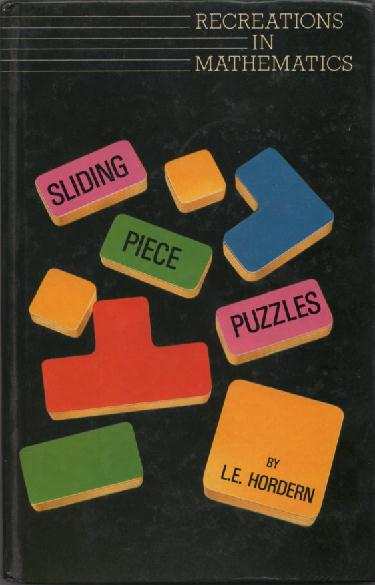
Sliding Block Puzzles
Hordern, L.E. -- Sliding Piece Puzzles, 1986, Oxford University Press, 249 pp., hardback, ISBN 0-19-853204-0, £15.00
Definitive work on sliding block puzzles, starting with the
Fifteen Puzzle and its variants, and including railway shunting
puzzles, the Parking Lot puzzle invented by Don Rubin (often misattributed elsewhere to
Nob Yoshigahara), and Sokoban (warehouse puzzles). Part of
Oxford's Recreations in Mathematics series (edited by David Singmaster), which also includes
Beasley's book on peg solitaire (see above) and Rubik's Cubic
Compendium by Rubik et al.
[my review from WGR7, October 1987, pp.20-21]
In contrast to peg solitaire, whose mathematical theory is fairly well
understood, sliding block puzzles have not been studied deeply, and
much of what is known has been found by trial and error. Sliding
Piece Puzzles, therefore, is a rather nontechnical book, the bulk of
which is devoted to descriptions of over 270 sliding piece puzzles,
with diagrams and complete instructions. For most puzzles, the
minimum number of moves (defined in one of two ways) needed for
solution is given; many of the solutions are improvements over previous
ones. The inventor and dates of invention and publication are
also given where known. Special features and solving hints are
given where appropriate. Each puzzle is rated for difficulty, and
the best puzzles in each chapter are listed. Complete solutions
for most of the puzzles are provided. The problems within each
chapter gradually increase in difficulty, and a number of problems are
included for instructional purposes, so that the reader learns
essential techniques.
Hordern also includes a history of sliding piece puzzles. He
presents good evidence that Sam Loyd did not actually invent the famous
Fifteen Puzzle as is commonly believed. He also describes the
taxonomy of sliding piece puzzles, dividing them into four groups:
sliding block puzzles (each piece moves independently), railway
shunting puzzles (one or two pieces push or pull the rest), Soko or
warehouse puzzles (one piece pushes the rest), and sliding puzzles with
plungers or levers (pieces move in groups). The latter group,
similar in many respects to twisting (rotational) puzzles such as
Rubik's Cube, are not covered in the book because of the difficulty of
making them. A sheet of 53 precut cardboard pieces is provided;
these are sufficient to solve about 230 of the puzzles. Detailed
instructions for making more substantial pieces are also given.
Six pages of color illustrations illustrate over 70 puzzles. A
bibliography and a list of patents are given in appendices.
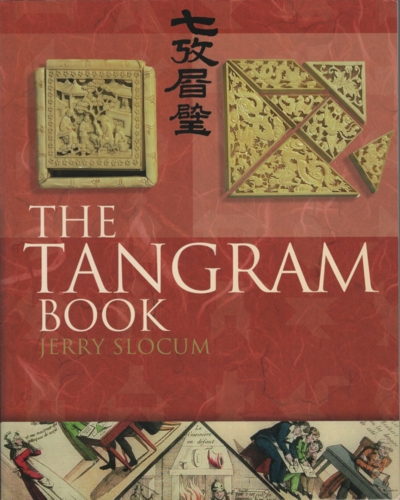
Tangrams
Crawford, Chris -- Tangram Puzzles, 500 Tricky Shapes to Confound and
Astound, 2002, Sterling, 96pp., hardback, ISBN 0-8069-7589-X,
$14.95 [wooden set]
Elffers, Joost -- Tangram, The Ancient Chinese Shapes Game, 1973, 1976,
Penguin, 214pp., paperback, $6.95 [acrylic set]
Loyd, Sam -- The Eighth Book of Tan (Sam Loyd's Book of Tangram
Puzzles), 1903, 1968, Dover, 52pp., paperback, ISBN 0-486-22011-7, $4.50
Read, Ronald C. -- Tangrams, 300 Puzzles, 1965, Dover, 152pp., paperback, ISBN 0-486-21483-4
Slocum, Jerry -- The Tangram Book, 2004, Sterling, 191pp., paperback, ISBN 1-4027-1688-5, $14.95
The definitive work on the subject, by one of the world's leading
authorities on the history of puzzles. Illustrated in full color
with hundreds of photographs. Slightly less than half the book
gives over 2000 figures assembled from 20 different historical sources,
with full solutions. Includes a full index and a six-page
annotated bibliography.
Van Note, Peter -- Tangrams, Picture-Making Puzzle Game, 1966, Charles
E. Tuttle, 55pp., paperback, ISBN 0-8048-0567-9, $3.25
[thin cardboard set]
Most recently edited on June 2, 2024.
This article is copyright
©2024 by Michael Keller. All rights reserved.




